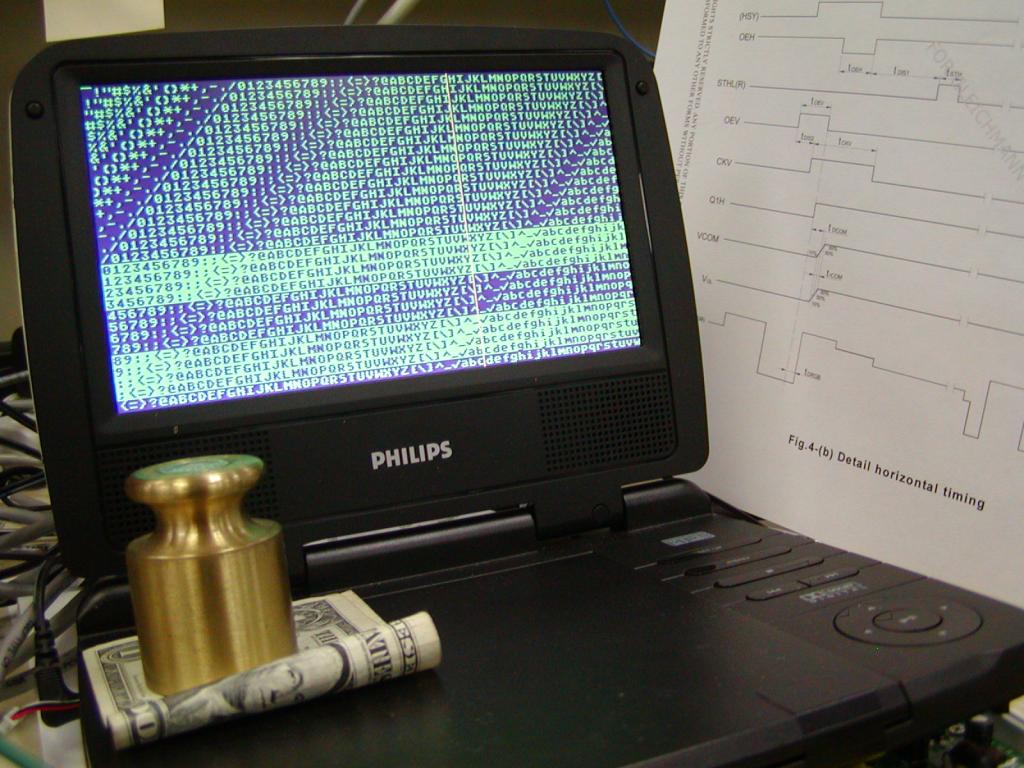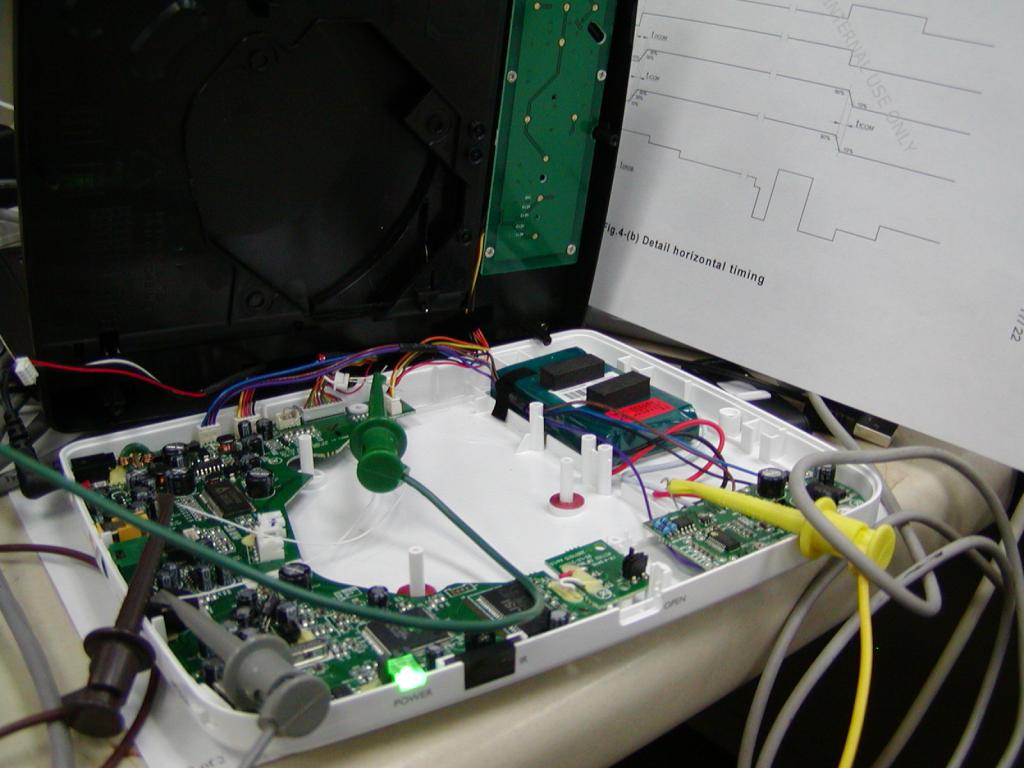29 lines of 60 characters on a 7-inch portable LCD
 localroger
Posts: 3,452
localroger
Posts: 3,452
I have successfully hacked the Philips PET 702 portable DVD player to act as a display for the Propeller. The first photo shows the player displaying 29 lines of 60 8x8 characters. Unfortunately, the dot clock is a bit too fast for an aiGeneric style display with every character its own color, but the 29 lines can all be different colors.
The PET 702 is no longer in current production, but both new and used units seem to be plentiful on eBay. The used units that "work except won't play a DVD" should be especially attractive, since these players don't have a normal A/V input and can't be used as monitors without this hack.
The first photo shows the display. It's green because I"m only driving the green signal, and the vertical line is there because I damaged the LCD removing the bezel (which turned out to be unnecessary; in any case I have a couple more of these units). The dollar bill gives perspective; this is a really small, portable device! It's very light too, especially with the DVD deck absent. The second photo shows the inside view of the open unit with the signal taps.
The factory AC adapter, on/off switch, and battery charge/discharge circuit should continue to function normally. The PET 702 also has 5V, 3V3, and 1V8 power supplies, as well as the control keyboard and speakers which should be hijackable. There is a low-battery warning signal which should be readable, and the firmware will automatically dim the backlight (even after the hack) if it is on battery power. With the DVD deck gone there is a lot of room in the case for extra electronics. The DVD deck cover door makes it possible to easily do a very clean hack that would look factory until you open it up with the original factory latch.
I have included a somewhat cleaned up version of the proof of concept driver. The service manual is available online (the filename is in the source code, search for it). It is obviously possible to go in a lot of different directions from here; if there is interest I could do a detailed writeup of how to do the hack in a blog.
UPDATE: I After a few hours of squinting at the nearly illegible and out of date schematic in the Service Manual and examining the circuit board with a copy lens for a magnifying glass, I have positively identified (1) very easy points to get power GND and 3V3, (2) the low voltage detector output, and (3) where to inject audio by either removing two SMT capacitors or just leaving them in and tack-soldering to piggyback on whatever the DVD might ever say. I know I can also read the IR remote control (you'd have to disconnect the output pin to keep the player firmware from interpreting commands, but it's not a SMT device so not a problem) because I've used the remote in another project with the remote control obex object. So this is shaping up to be far more than just a display; it's the skeleton for a very capable portable device. I will be doing a more permanent mod with a protoboard soon and test all the functions and will post results as they become available.
The PET 702 is no longer in current production, but both new and used units seem to be plentiful on eBay. The used units that "work except won't play a DVD" should be especially attractive, since these players don't have a normal A/V input and can't be used as monitors without this hack.
The first photo shows the display. It's green because I"m only driving the green signal, and the vertical line is there because I damaged the LCD removing the bezel (which turned out to be unnecessary; in any case I have a couple more of these units). The dollar bill gives perspective; this is a really small, portable device! It's very light too, especially with the DVD deck absent. The second photo shows the inside view of the open unit with the signal taps.
The factory AC adapter, on/off switch, and battery charge/discharge circuit should continue to function normally. The PET 702 also has 5V, 3V3, and 1V8 power supplies, as well as the control keyboard and speakers which should be hijackable. There is a low-battery warning signal which should be readable, and the firmware will automatically dim the backlight (even after the hack) if it is on battery power. With the DVD deck gone there is a lot of room in the case for extra electronics. The DVD deck cover door makes it possible to easily do a very clean hack that would look factory until you open it up with the original factory latch.
I have included a somewhat cleaned up version of the proof of concept driver. The service manual is available online (the filename is in the source code, search for it). It is obviously possible to go in a lot of different directions from here; if there is interest I could do a detailed writeup of how to do the hack in a blog.
UPDATE: I After a few hours of squinting at the nearly illegible and out of date schematic in the Service Manual and examining the circuit board with a copy lens for a magnifying glass, I have positively identified (1) very easy points to get power GND and 3V3, (2) the low voltage detector output, and (3) where to inject audio by either removing two SMT capacitors or just leaving them in and tack-soldering to piggyback on whatever the DVD might ever say. I know I can also read the IR remote control (you'd have to disconnect the output pin to keep the player firmware from interpreting commands, but it's not a SMT device so not a problem) because I've used the remote in another project with the remote control obex object. So this is shaping up to be far more than just a display; it's the skeleton for a very capable portable device. I will be doing a more permanent mod with a protoboard soon and test all the functions and will post results as they become available.





Comments
This will make a great output device for many projects; especially with very low cost "rescued" LCD's.
Craigslist can be another source of similar displays.
@potatohead: Thanks too. The dot clock is 9 MHz, so the timing isn't nearly as tight as VGA. In fact I've thought of a way to do individual character colors, although it would have to be limited to 8 colors emitted on 3 consecutive pins of the VGA block (you'd get as many tiles as you want as a tradeoff though) and EITHER (1) background is always %000, (2) use a pre-reversed font, or (3) pin group is always pins 012 of the VGA block.
Now I need to make a proper permanent version of the hack on one of my undamaged units, which will be my next project. I also need to find some signals on the main board.
Of course, if as you suggested earlier one was to just throw another cog or two at it, this thing could sing. For one thing full 8-bit color depth is possible since outgoing sync signals aren't needed.
I am also seriously tempted to see if Office Depot still has that 7-inch LCD photo frame still on sale on the off chance...
On edit: I didn't realize you were the one that ripped it, potatohead. It's a great font for this sort of thing. Atari knew what they were doing.
I think so too. I've always liked it, because it was designed for TV. It happens to read well at the higher character densities, due to very few single pixels.